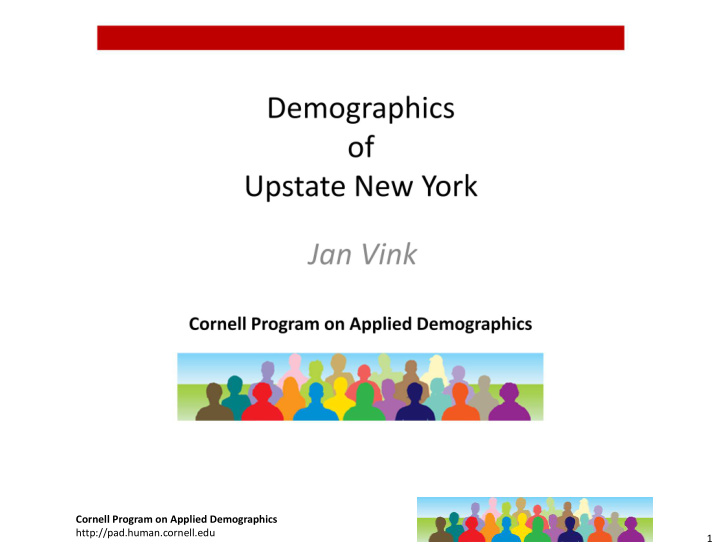



Cornell Program on Applied Demographics http://pad.human.cornell.edu 1
Why is density important? • Think of service areas and • Access to health care Cornell Program on Applied Demographics http://pad.human.cornell.edu 2
• Growth and decline is now evenly spread throughout the state • Many towns and cities saw a decline in population between 2000 and 2010 • What makes certain towns in your area more or less “attractive”? Cornell Program on Applied Demographics http://pad.human.cornell.edu 3
• 85 and over population in 2010 much larger than in 2000 • Babyboom generation caused large increases in 55-64 year old • What age groups are expected to grow in the next 10 years? Cornell Program on Applied Demographics http://pad.human.cornell.edu 4
Median age is number for which half of the population is younger and half is older What are the differences between “young” and “old” towns? Cornell Program on Applied Demographics http://pad.human.cornell.edu 5
There are areas with relative larger proportions of 85 and older Cornell Program on Applied Demographics http://pad.human.cornell.edu 6
What causes differences? • Age structure in 2000 • Different mortality rates and/or • Migration? Cornell Program on Applied Demographics http://pad.human.cornell.edu 7
Projection data from Cornell Program on Applied Demographics • Total population – little change • Large increases in the coming two decades in 65 and over • Age 85 and over – small increases coming two decades and sharp increase between 2030 and 2040 Cornell Program on Applied Demographics http://pad.human.cornell.edu 8
Non Hispanic White alone population by far the largest group, but this group saw a decline in the last decade Hispanic and Asian populations showed the largest increases Cornell Program on Applied Demographics http://pad.human.cornell.edu 9
The share of the white population is smaller at younger ages Hispanic largest minority at younger ages What does this mean for diversity in schools & workplace? Cornell Program on Applied Demographics http://pad.human.cornell.edu 10
30% of all population age 65 year lives alone. Cornell Program on Applied Demographics http://pad.human.cornell.edu 11
Cornell Program on Applied Demographics http://pad.human.cornell.edu 12
Cornell Program on Applied Demographics http://pad.human.cornell.edu 13
Cornell Program on Applied Demographics http://pad.human.cornell.edu 14
Cornell Program on Applied Demographics http://pad.human.cornell.edu 15
Cornell Program on Applied Demographics http://pad.human.cornell.edu 16
• Percent of people with disability • Residents of prisons, hospitals and nursing homes are excluded from these statistics • Keep in mind that these numbers come with Margins of Error Cornell Program on Applied Demographics http://pad.human.cornell.edu 17
• Percent without Health Insurance • Residents of prisons, hospitals and nursing homes are excluded from these statistics • Keep in mind that these numbers come with Margins of Error Cornell Program on Applied Demographics http://pad.human.cornell.edu 18
• Percent of population without a High School Degree • Keep in mind that these numbers come with Margins of Error • What kind of things do we associate with people without a high school degree? Cornell Program on Applied Demographics http://pad.human.cornell.edu 19
Cornell Program on Applied Demographics http://pad.human.cornell.edu 20
Cornell Program on Applied Demographics http://pad.human.cornell.edu 21
Recommend
More recommend